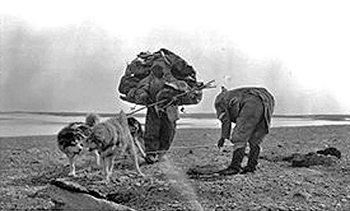From the Editor: Heading Out and Coming Home
Far Fur Country Documentary Projects Come to Fruition!
The Epidemiology of Rabies in the Canadian North
Okpik’s Dream en Route to Completion
Puvirnituq Snow Festival
Book Review: How to Build an Iglu and a Qamutiik
IMHO: The Best Laid Plans
Navigating This Site
Index of articles by subject
Index of back issues by volume number
Search The Fan Hitch
Articles to download and print
Ordering Ken MacRury's Thesis
Our comprehensive list of resources
Defining the Inuit Dog
Talk to The Fan Hitch
The Fan Hitch home page
Editor: Sue Hamilton
Webmaster: Mark Hamilton
The Fan Hitch, Journal
of the Inuit Sled Dog, is published four
times a year. It is available at no cost
online at: https://thefanhitch.org.
The Fan Hitch welcomes your letters, stories, comments and suggestions. The editorial staff reserves the right to edit submissions used for publication.
Contents of The Fan Hitch are protected by international copyright laws. No photo, drawing or text may be reproduced in any form without written consent. Webmasters please note: written consent is necessary before linking this site to yours! Please forward requests to Sue Hamilton, 55 Town Line Rd., Harwinton, Connecticut 06791, USA or mail@thefanhitch.org.
This site is dedicated to the Inuit Dog as well as related Inuit culture and traditions. It is also home to The Fan Hitch, Journal of the Inuit Sled Dog.
The Fan Hitch welcomes your letters, stories, comments and suggestions. The editorial staff reserves the right to edit submissions used for publication.
Contents of The Fan Hitch are protected by international copyright laws. No photo, drawing or text may be reproduced in any form without written consent. Webmasters please note: written consent is necessary before linking this site to yours! Please forward requests to Sue Hamilton, 55 Town Line Rd., Harwinton, Connecticut 06791, USA or mail@thefanhitch.org.
This site is dedicated to the Inuit Dog as well as related Inuit culture and traditions. It is also home to The Fan Hitch, Journal of the Inuit Sled Dog.

"Ikpukkuak releases his three dogs for packing while Higilaq sets out
with her backpack near Ammalurtuq Lake, southwest Victoria Island;
1 July 1915, N.W.T. (Nunavut)." Jenness, Diamond, 1886-1969.
Courtesy, Canadian Museum of Civilization, (#36989; CD95-927-025)
The Epidemiology of Rabies in the Canadian North
by David Gregory, DVM
Taking the Bite out of Rabies: The Evolution of Rabies Management in Canada is a history and science book on rabies in Canada, with the management of rabies up to the present. Co-author Dr. Rowland Tinline and I plan to have it published in 2015. Roly and I are a good combination for this book. He was Professor Emeritus of Geography at Queens University and was very involved with the oral [rabies vaccine] bait program in Ontario. I worked for the Canadian Food Inspection Agency (CFIA), which used to be Agriculture Canada, for 24 years as Chief of Zoonotic Diseases before retiring.
With 38 chapters in the book we thought we had enough material but realized that a section was missing – the role of Inuit in rabies. We have a chapter dedicated to the First Nations point of view and feel that we also need something from the people living where rabies seems to have come from. There is a lot of folklore from Inuit in the Northwest Territories (NWT) and Nunavut (NU) about this disease affecting their dogs going back many years, probably before the first white settlers came to Canada. Where did Inuit come from and where did their dogs originate? Are Inuit in the NWT and NU of the same culture as those from Alaska and those that settled in Labrador and Greenland? Did they bring rabies with them with their dogs or was the disease already there? From the 1800s dogs and foxes were the main vectors and hosts. Why did it persist in the arctic and were there any human deaths as far as Inuit can remember? It seems not, perhaps due to their heavy clothing. Does anyone remember tales of rabies before the white man came?
Ed.: We are reaching out to people currently living in or otherwise intimately familiar with the Canadian Arctic and especially who have strong familiarity with the relationship of Inuit and their dogs and who also might be able to answer Dr. Gregory’s questions, adding to the body of knowledge to be included in Taking the Bite out of Rabies: The Evolution of Rabies Management in Canada. Please email Dr. David Gregory.